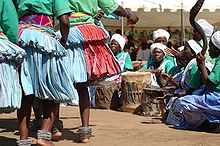Xibelani dance

The xibelani dance or shibelani dance is an indigenous dance of the Tsonga or Shangaan women of the Limpopo province in northern South Africa. The name of the dance comes from the native Xitsonga language.
Method
In the xibelani dance the Tsonga women tie a type of African skirt—the xibelani commonly known as "tinguvu"—around their waist and then shake from the waist. The xibelani skirt is designed to make the wearer's hips look bigger, and thereby to emphasise the shaking.
Uses
It is customary for Tsonga girls learn the xibelani dance, and it is a way for them to express pride in their cultural heritage. The xibelani dance is used on occasions such as mkhinyavezo and ku chachula,as well as to accompany other traditional dances such as the makhwaya and mchongolo. Traditionally women dance the xibelani, while men perform the makhwaya, Xincayinciy(xigubu) and both participate in the mchongolo.
The Tsonga's perform the xibelani dance to their own distinct music, and it has become typical for all Tsonga bands to have female xibelani dancers. The xibelani and tshetsha dances have experienced regained popularity in modern Giyani as the people have embraced their traditional ways.
While the xibelani dance is customary for women, some men now also participate in it, especially when there is a xiseveseve (a type of party). In modern society the xibelani dance is regarded as an open dance in which everyone can participate, and it is used both in church as well as in rituals.